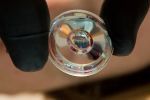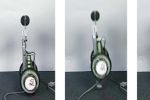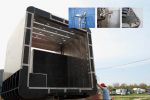Blowing (Up) Hydrogen Bubbles
Living in the Midwest, where heating homes with propane is common, I periodically see reports in the local paper that yet another unoccupied house has exploded. They often note that the roof was found in the basement, while the walls were spread some distance into the neighboring fields.
Roof-in-basement syndrome begins when propane, which is heavier than air, leaks and fills up the lower levels of a house, mixing with the home's ambient air. Once the layer of gas reaches the height of a pilot light in a stove, it triggers a huge explosion. (The refinery adds a very strong odor to propane, so if people are home, they typically notice the leak before the concentration approaches a dangerous level.)
Why does the same gas that burns gently in a furnace turn into an explosive menace when it leaks? Without oxygen, propane can't burn. You could light a match inside a propane tank, and nothing would happen. Furnaces control the rate of burning by mixing propane with air slowly as it burns. But premix large amounts, and the results are very different.
I've done this demonstration several times with people unfamiliar with just how much power can be tied up in a few soap bubbles. I've never actually blown a window out, but I think I have knocked a few socks off.
Making Hydrogen Bubbles
THE SETUP
High-pressure tanks of hydrogen [red] and oxygen [yellow] supply the raw elements for this demonstration. What keeps it safe are devices at the ends of the hoses called flashback arrestors that prevent the gases from mixing inside the canister.
Achtung! Theodore Gray is trained in lab safety. Don’t try this at home. See more of Gray’s work at periodictable.com.
1 Comment
Popular Tags
Regular Features

Featured
DIY
The Graffiti Laser
Combining salvaged parts and an unusual light source, a DIY slide projector beams strange, mesmerizing images from hundreds of feet awayDIY Paradise at Maker Faire
The annual Bay Area carnival attracts the best Makers in the land. See what caught our eye this year









Comments
People don't seem to realise just how devastating the results can be when you have a simple gas leak, yet they were overly concerned that the hydrogen-powered car could spontaneously explode or that a damaged nuclear reactor would lead to a nuclear explosion.
There's a lot of myths in the scientific world that need to be debunked.
3 out of 3 people found this comment helpful